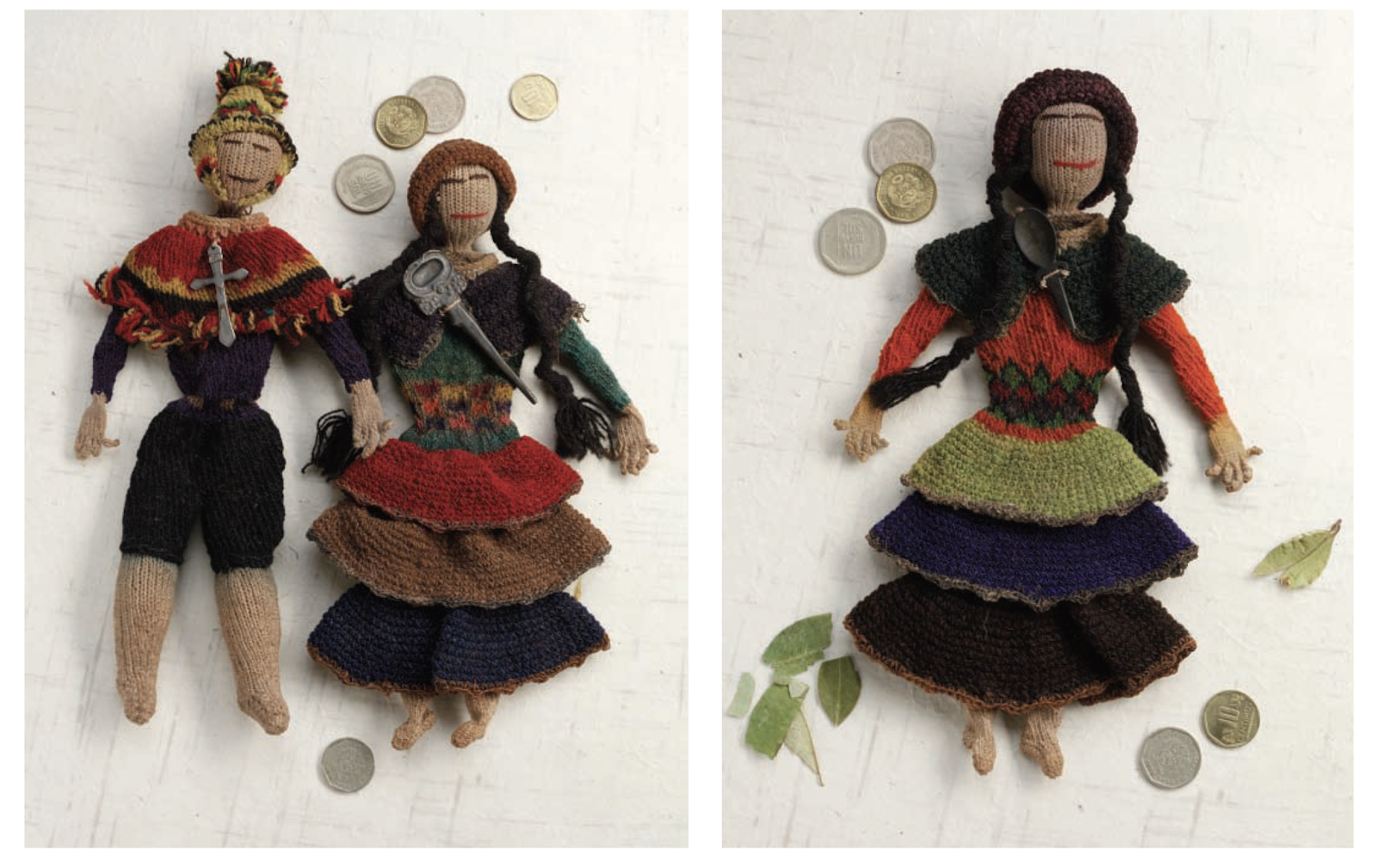https://pieceworkmagazine.com/cdn-cgi/image/format=auto/https://www.datocms-assets.com/75076/1656652853-screen-shot-2021-06-24-at-2-30-05-pm.png?auto=format&w=900
What do a striped fish, a well-dressed woman, a tonsured monk, and an anatomically correct bull have in common? For at least a hundred years, women in Peru and Bolivia have carried all these shapes as fashionable little monederos (coin purses).
Whether intended as ritual funerary objects, garment embellishments, or utilitarian containers, three-dimensional figures have a long tradition in Andean textile history. Two thousand years ago, Paracas women of the south Pacific coast of Peru were making colorful little figures in the needlework technique called cross-looping, considered a precursor to knitting. A magnificent example of their work, the Paracas Textile, a mantle from Paracas, Peru, dated 300 B.C.–A.D. 100, in the collection of the Brooklyn Museum, is edged with a fringe of ninety detailed miniature people and animals (see “Historical Notes and Resources” below).
[PAYWALL]
A thousand years later, the Chancay of the north Pacific coast of Peru were fashioning little figures to tuck into funeral bundles, likely as symbolic escorts to accompany the dead. Woven tapestry faces and tiny dresses embellish the stuffed figures; yarn-wrapped twigs form the hands, feet, arms, and legs. The Chancay also knew how to cross-loop as shown by the small cross-looped figures (probably associated with magic rather than play) that decorate the front of a Chancay child’s shirt in the collection of the Gold Museum in Lima.
Andean textile artists also created functional, three-dimensional bags to carry such materials as coca leaves or dye plants. These clever women were familiar with nearly every possible hand manipulation of fiber—an incredible variety of ingenious weaving, looping, knotting, and netting techniques. They spun and dyed native cotton and the hair of alpacas and llamas—sheep’s wool was not available until after sheep from the Iberian Peninsula were introduced into South America by early Spanish and Portuguese settlers.
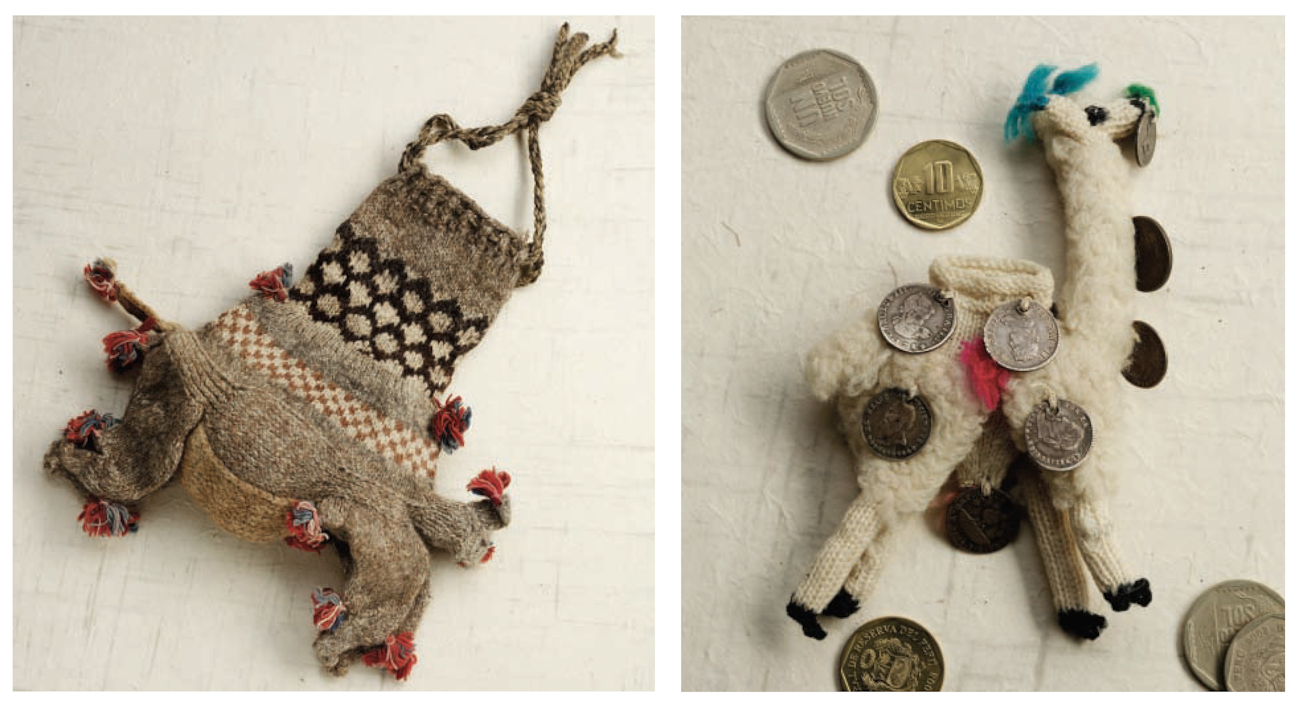
Left: Llama-shaped purse. Maker unknown. Knitted. Handspun alpaca. Potosi Department, Bolivia. Mid-twentieth century. 9½ inches (24.1 cm) tall. Collection of the author. Right: Llama-shaped purse with coins attached. Maker unknown. Knitted and embroidered. Handspun sheep’s wool. Bolivia. Late nineteenth to early twentieth century. 4 inches (10.2 cm) tall. Collection of the author. Photographs by Joe Coca.
Some of these men had worked in the European trade guilds, and some must have developed excellent knitting skills. We can imagine the men knitting replacements for their worn-out socks and caps during the long ship voyage to the Americas; theoretically, they hit the shore knowing how to knit. From here on, the knitting history is as fuzzy as a baby alpaca.
By the late seventeenth century, many Spanish and Portuguese women had braved the seas to join husbands or brothers. (Magnus Mörner and Dorothy A. Mays, among others, relate their interesting stories; see Further Reading below.) The women, who enjoyed knitting gloves and coin purses in their spare time, most likely passed on their knitting skills to the indigenous women; picking up another technique probably would have been easy for such experienced textile artists. I have no evidence that Iberian men who were knitters in the old country passed on their skill to either native men or women, but since many of them married or lived with native women, such a transfer seems likely.
Whenever and however the native people learned to knit, they ran with it. At least since the late nineteenth century, Andean textile artists have been knitting complexly patterned headgear, ceremonial offering bags, and marvelously whimsical figure purses. Men’s chuspas (coca bags), staidly rectangular, were woven, but for their own use, the women knitted monederos in fanciful shapes.
In 1880, the French traveler Charles Wiener described a visit to a Cuzco society lady: “Wrapped in a shawl, she receives her guests. She often carries a prayer book and a rosary; her coin purse is not in her pocket, but held in her hand. These pretty little purses are knit of silk and represent animals or people, fat or thin, according to the state of the lady’s finances.”
The silk would have been imported, of course, or a woman might have used soft native alpaca or vicuña yarns or a blend of vicuña and silk. An unusual or especially beautiful monedero was a source of great pride, and as Wiener noted, its owner carried it in her hand, to
be admired, its small size perfectly suited to the little gold and silver coins then in use.
A purse knitter worked in the round on a set of four or five double-pointed needles, usually draping the working yarn around her neck for tension control. Some knitters started out making a container that was basically cylindrical but then added a head and appendages to transform it into a human or animal form. In some cases, only the side pockets became little figures; in others, the entire purse became the figure. In many examples of animal-shaped purses, the legs serve as pouches for coins. Knitters often embroidered on additional details such as hair and facial features.
Some monederos boast real coins attached to the outside through holes drilled in the edges of the coins; I don’t know when this practice began, but the Peruvian purses sketched by Wiener in 1880 don’t have coins. The oldest purse in my collection, which does have coins attached, is the white llama shown above. I bought it about twenty-five years ago in an antique shop in La Paz, Bolivia, and I think that it dates from the 1920s or earlier because of the fine gauge and minute details; to my knowledge, nothing like it exists in any museum or private collection. It is knitted from very finely spun sheep’s wool and measures just 4 inches (10.2 cm) high.
Working in the round on fine metal needles, the skillful knitter achieved a gauge of 14 stitches per inch (about 5½ stitches per cm). The belly forms the main pouch, with eyelet stitches around the opening to hold a (missing) cord; the four carefully shaped legs are knitted down to black hooves from stitches picked up from the back. After completing the knitting, the maker stitched fine wool roving in vertical herringbone lines on the outside haunches and neck to make a furry pelt. She picked up a few stitches on the head to knit tiny ears and added tassels just like those seen on real llamas in the Bolivian highlands.
The coins stitched to the llama are interesting and rare. A silver Bolivian ¼ sol, only ½ inch (1.3 cm) across and stamped “Potosi” and “1852,” bears the image of a tiny llama! The oldest coin is a Charles III (1716–1788, “King of Spain and the Indies”) Spanish real from 1784; reales were used in all the Hispanic colonies. A coin with a sun motif says “Cuzco 1837.” Although the coins could have been added later by someone other than the maker, the purse itself is clearly old and the knitting techniques, ingenious and exacting.
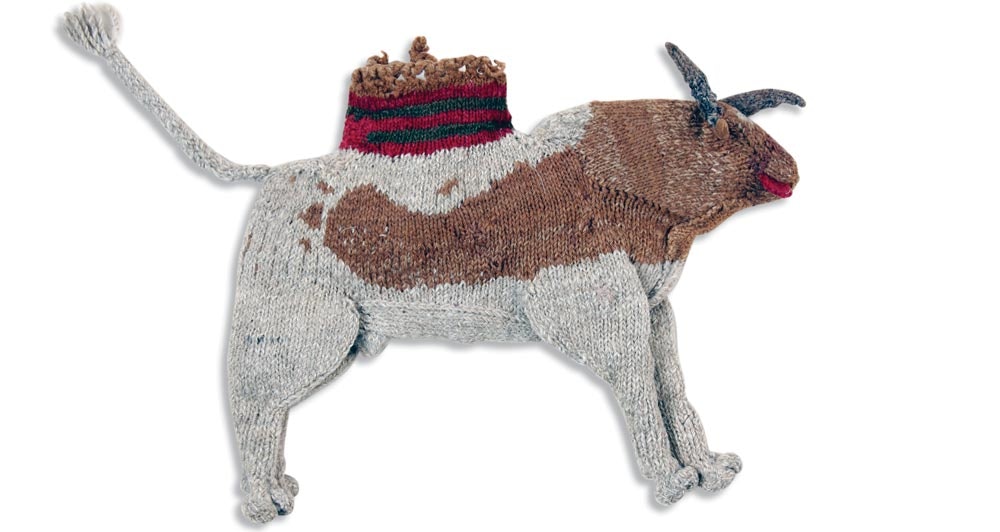
Bull-shaped purse. Maker unknown. Knitted. Undyed and plant-dyed handspun sheep’s wool. Bolivian Altiplano. Early to mid-twentieth century. 8 inches (20.3 cm) tall. Collection of Jonathan Hill. Photograph by Ann Swanson.
The Bolivian bull monedero shown above is 8 inches (20.3 cm) tall and is knitted from handspun undyed and plant-dyed sheep’s wool with a hollow body and leg pouches. The same knitter probably made the similarly constructed llama-shaped purse, shown at right, as well; it was knitted in the same manner with the same materials.
The male and female figure purses (top) most likely were created by the same Peruvian knitter. The knitter formed the heads and stuffed them, then knitted the tubular bodies to serve as purses. The little knitted arms end in tiny fingers. She began the woman’s clothing by knitting the body as a dress with multicolored patterning around the waist, then picked up stitches from the dress/body and crocheted the tiered skirt, shawl, and hat. The male figure has a poncho that begins at the top from stitches picked up around the neck. Both purses open at the front of the neck, and both have an antique silver charm stitched to the chest.
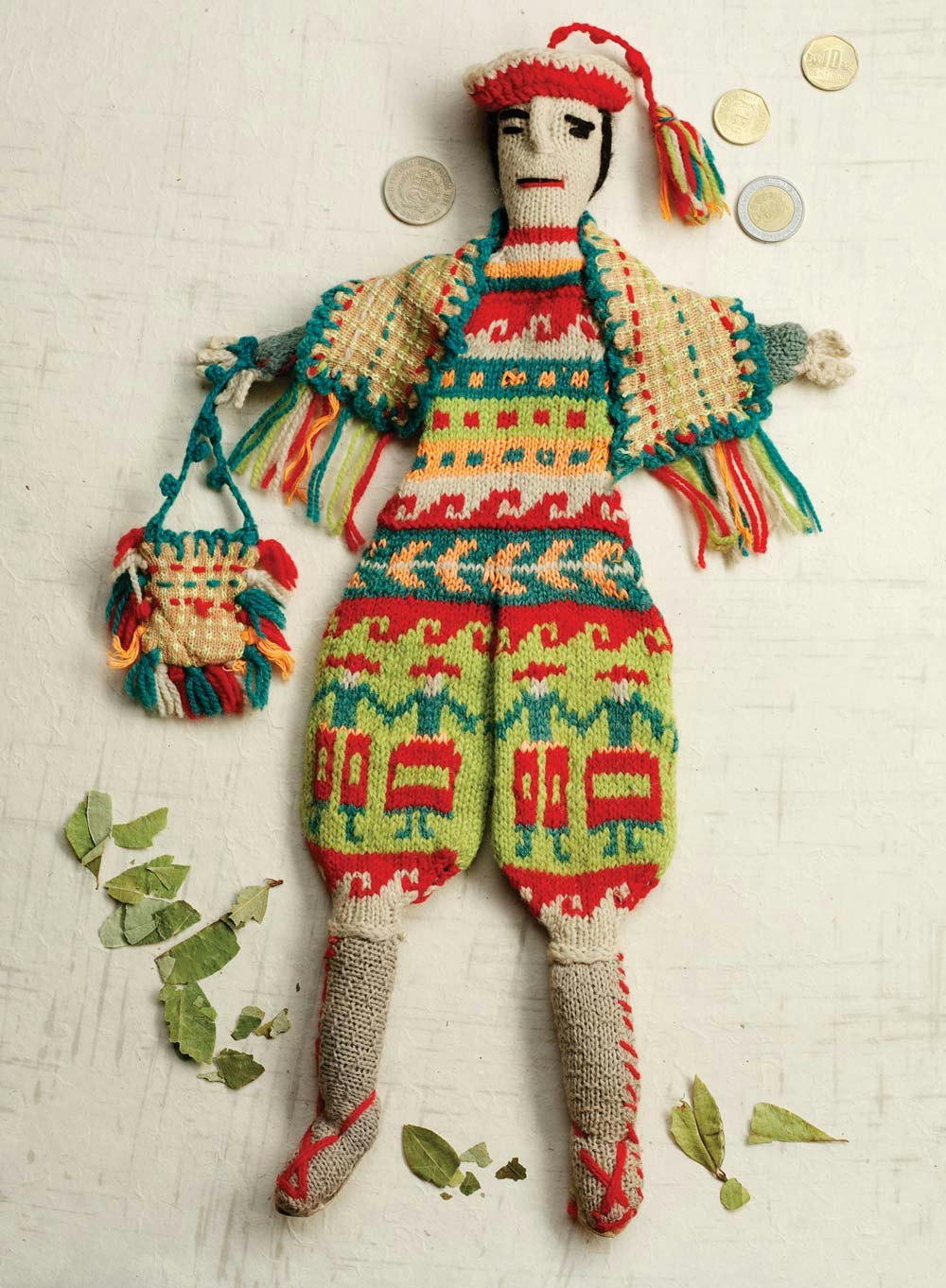
Figure purse. Maker unknown. Knitted and embroidered. Factory wool with commercially knit fabric shawl. Chuquisaca, Bolivia. Mid- to late twentieth century. 16 inches (40.6 cm) tall. Collection of the author. Photograph by Joe Coca.
The male figure’s Bolivian counterpart is similar but almost twice as tall. The opening to insert coins is at the back of his neck instead of in front. His patterned, hollow body extends into pant legs; a stuffed leg has been stitched into each pant opening to form the bottom of the pouch. His shoulder wrap and coca pouch appear to have been cut from the same piece of factory-knit fabric. A red hat with tassels, embroidered black hair, and little cardboard sandals complete the dapper figure.
One of the highlights of The Finishing Touch: Accessories from the Bolivian Highlands, an exhibition at The Textile Museum in Washington D.C., is a wonderful figure purse. This sweet little lady, probably from the La Paz area, is knitted from sheep’s wool. She has a stuffed head and a fancy crocheted hat. Her body begins with an eyelet-hole row for a (missing) cord, then continues as a blouse with two-stitch-wide red-and-white stripes. The garter-stitch striped arms are sewn on. At the waist, the knitter increased stitches for a skirt made of knitted bands of detailed human figures and flowerlike motifs finished off with rows of little crochet scallops. The feet and shoes also are crocheted, as is the peplum at her waist.
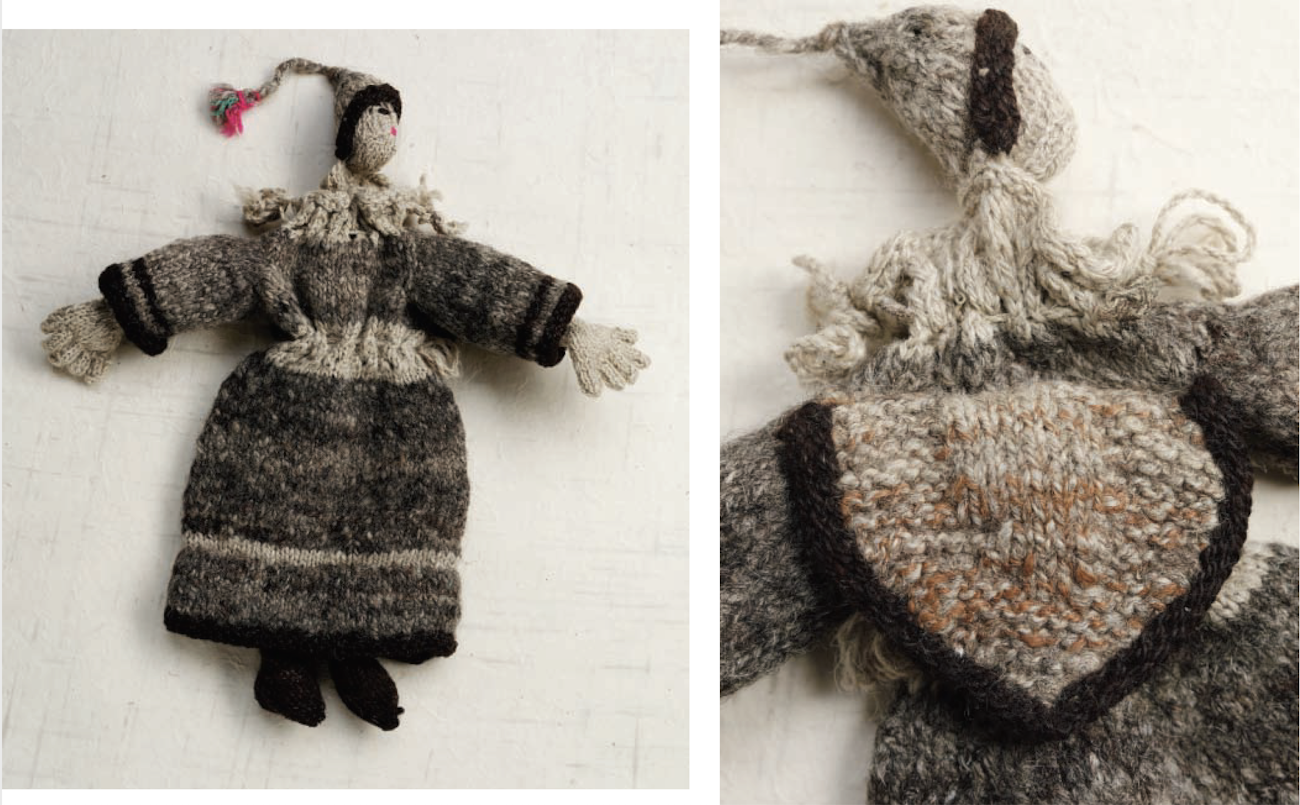
Left: Monk figure purse. Maker unknown. Knitted and embroidered. Handspun sheep’s wool and alpaca. Mid- to late twentieth century. 10 inches (25.4 cm) tall. Collection of the author. Right: Detail of monk figure purse, showing tonsure and cape. Photographs by Joe Coca.
The monk bag shown above was knitted in Bolivia from handspun undyed sheep’s wool and alpaca. Under the hood is the realistic shorn head of a tonsured monk; down his back hangs a short cape. I wish we could get him to tell his story.
John Goins, in his study of the Quechua-speaking people of the Cochabamba Valley of Bolivia (see Further Reading), notes that no Quechua woman felt dressed without her knitted purse. She wore it around her waist, stitched onto a special cord that she bought in the market, hanging out over her skirt but under her blouse and apron. Goins recounts that some of the boys whom he interviewed bragged that they used to sneak a pair of scissors into a festival, and then, while everyone else was distracted by the dancing and festivities, they would snip the bottoms of pouched purses and catch any coins that fell out in their cupped hands.
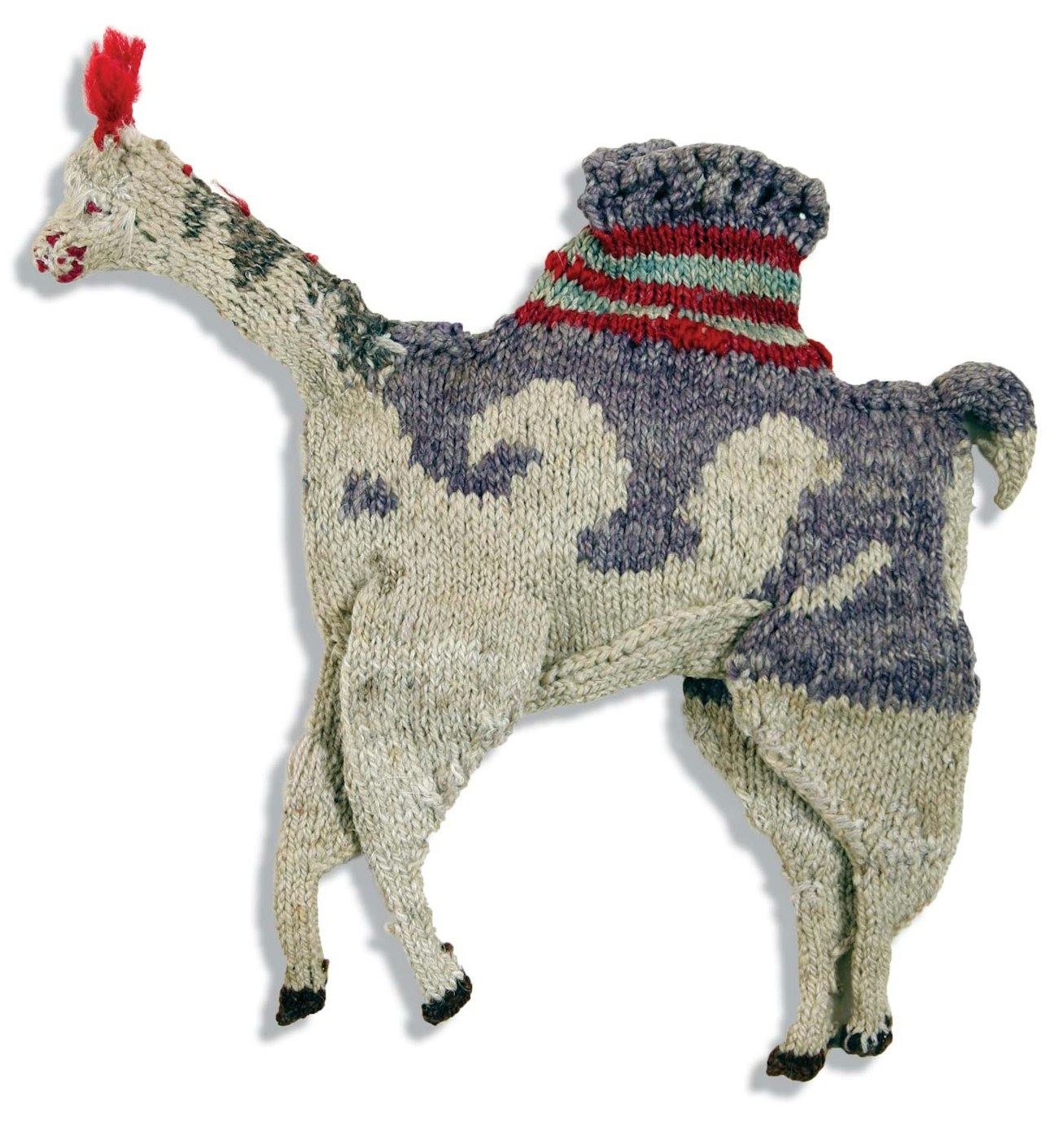
Llama-shaped purse. Maker unknown. Knitted. Undyed and plant-dyed handspun sheep’s wool. Bolivian Altiplano. Early to mid-twentieth century. 8 inches (21.6 cm) tall. Collection of Jonathan Hill. Photograph by Ann Swanson.
The Bolivian llama-shaped bag with its carefully shaped pouched legs and rotund belly is knitted from the top down of undyed sheep’s wool. The legs and head look almost like an afterthought. This bag, which measures about 9½ inches (24 cm) tall, was made during the 1980s, a period of hyperinflation when a woman needed a roomy purse to carry enough paper bills to buy a few groceries (at its worst, 2 million peso bolivianos equaled one U.S. dollar).
Today, you don’t need a huge purse to carry your money to go grocery shopping in Bolivia. But women in both Bolivia and Peru still do make and use three-dimensional figure purses, whose roots lie in the ancient cross-looped figures mentioned above. Today, while knitters often favor fluorescent synthetic yarns, their technical skill and ingenuity remain as high as ever.
Further Reading
d’Harcourt, Raoul. Textiles of Ancient Peru and Their Techniques. 1934. Reprint, Mineola, New York: Dover, 2002.
Goins, John Francis. Huayculi: Los Indios Quichua del Valle de Cochabamba, Bolivia (Huayculi: Quechua Indians of the Cochabamba Valley, Bolivia). Mexico City: Instituto Indigenista Interamericano, Ediciones Especiales: #47, 1967.
LeCount, Cynthia Gravelle. Andean Folk Knitting: Traditions and Techniques from Peru and Bolivia. St. Paul, Minnesota: Dos Tejedoras, 1990.
Mays, Dorothy A. Women in Early America: Struggle, Survival, and Freedom in a New World. Santa Barbara, California: ABC-CLIO, 2004.
Meisch, Lynn A. Traditional Textiles of the Andes: Life and Cloth in the Highlands. New York: Thames and Hudson, 1997. Out of print.
Mörner, Magnus. “Changing Attitudes: Early Spanish Immigrants in the New World.” Lecture abstract, Hamburg, Germany, October 25, 2000.
Wilson, Kax. “Where Sand Falls Like Rain: Needleknitting from Ancient Peru.” PieceWork September/October 1993.

